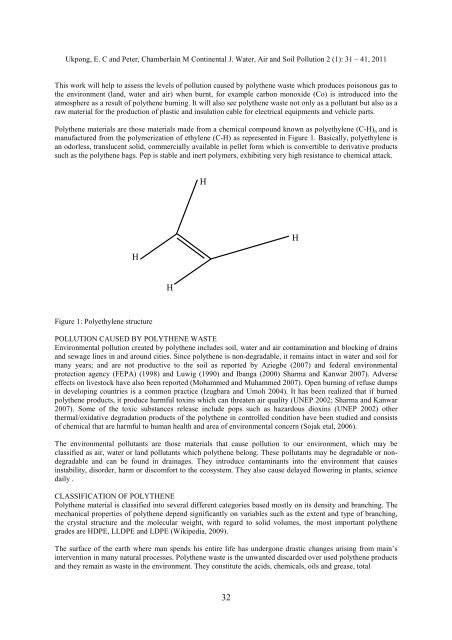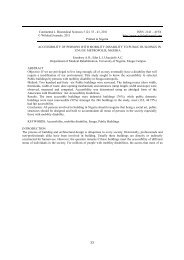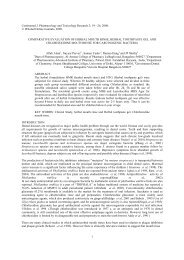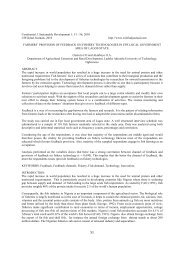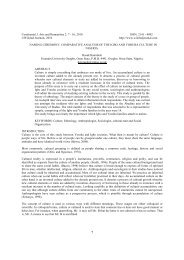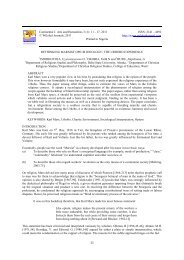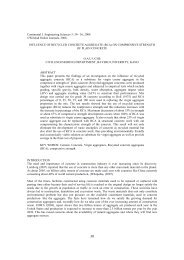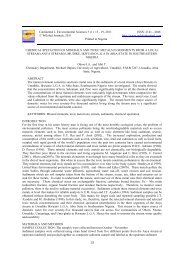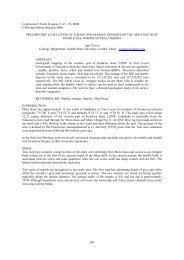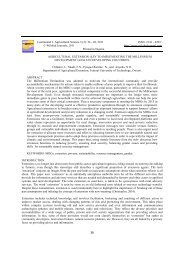Ukpong, E. C <strong>and</strong> Peter, Chamberlain M <strong>Cont</strong>inental J. <strong>Water</strong>, <strong>Air</strong> <strong>and</strong> <strong>Soil</strong> <strong>Pollution</strong> 2 (1): 31 – 41, 2011This work will help to assess the levels of pollution caused by polythene waste which produces poisonous gas tothe environment (l<strong>and</strong>, water <strong>and</strong> air) when burnt, for example carbon monoxide (Co) is introduced into theatmosphere as a result of polythene burning. It will also see polythene waste not only as a pollutant but also as araw material for the production of plastic <strong>and</strong> insulation cable for electrical equipments <strong>and</strong> vehicle parts.Polythene materials are those materials made from a chemical compound known as polyethylene (C-H) n <strong>and</strong> ismanufactured from the polymerization of ethylene (C-H) as represented in Figure 1. Basically, polyethylene isan odorless, translucent solid, commercially available in pellet form which is convertible to derivative productssuch as the polythene bags. Pep is stable <strong>and</strong> inert polymers, exhibiting very high resistance to chemical attack.HHHHFigure 1: Polyethylene structurePOLLUTION CAUSED BY POLYTHENE WASTEEnvironmental pollution created by polythene includes soil, water <strong>and</strong> air contamination <strong>and</strong> blocking of drains<strong>and</strong> sewage lines in <strong>and</strong> around cities. Since polythene is non-degradable, it remains intact in water <strong>and</strong> soil formany years; <strong>and</strong> are not productive to the soil as reported by Aziegbe (2007) <strong>and</strong> federal environmentalprotection agency (FEPA) (1998) <strong>and</strong> Luwig (1990) <strong>and</strong> Ibanga (2000) Sharma <strong>and</strong> Kanwar 2007). Adverseeffects on livestock have also been reported (Mohammed <strong>and</strong> Muhammed 2007). Open burning of refuse dumpsin developing countries is a common practice (Izugbara <strong>and</strong> Umoh 2004). It has been realized that if burnedpolythene products, it produce harmful toxins which can threaten air quality (UNEP 2002; Sharma <strong>and</strong> Kanwar2007). Some of the toxic substances release include pops such as hazardous dioxins (UNEP 2002) otherthermal/oxidative degradation products of the polythene in controlled condition have been studied <strong>and</strong> consistsof chemical that are harmful to human health <strong>and</strong> area of environmental concern (Sojak etal, 2006).The environmental pollutants are those materials that cause pollution to our environment, which may beclassified as air, water or l<strong>and</strong> pollutants which polythene belong. These pollutants may be degradable or nondegradable<strong>and</strong> can be found in drainages. They introduce contaminants into the environment that causesinstability, disorder, harm or discomfort to the ecosystem. They also cause delayed flowering in plants, sciencedaily .CLASSIFICATION OF POLYTHENEPolythene material is classified into several different categories based mostly on its density <strong>and</strong> branching. Themechanical properties of polythene depend significantly on variables such as the extent <strong>and</strong> type of branching,the crystal structure <strong>and</strong> the molecular weight, with regard to solid volumes, the most important polythenegrades are HDPE, LLDPE <strong>and</strong> LDPE (Wikipedia, 2009).The surface of the earth where man spends his entire life has undergone drastic changes arising from main’sintervention in many natural processes. Polythene waste is the unwanted discarded over used polythene products<strong>and</strong> they remain as waste in the environment. They constitute the acids, chemicals, oils <strong>and</strong> grease, total32
Ukpong, E. C <strong>and</strong> Peter, Chamberlain M <strong>Cont</strong>inental J. <strong>Water</strong>, <strong>Air</strong> <strong>and</strong> <strong>Soil</strong> <strong>Pollution</strong> 2 (1): 31 – 41, 2011suspended solids, total dissolve solids, heavy metals ions, mercaptans, packaging materials, polyolefins,polystyrene for packaging electronic materials, radio <strong>and</strong> television sets.Of all classes of wastes, polythene waste posses the greatest threat to life, because it has the potential ofpolluting l<strong>and</strong>, water <strong>and</strong> air using water <strong>and</strong> air as transport media. <strong>Air</strong> pollution is one of the manyenvironmental problems posed to man from his surroundings. It is the presence of substances or contaminants inthe outdoor atmosphere in concentration large enough to be injurious to human, plants <strong>and</strong> animal life. <strong>Air</strong>pollution is caused by both natural <strong>and</strong> artificial means of introducing gasses or particulate substances(contaminants) into the atmosphere. The composition of air reveals some of the pollutants in the atmosphere.Polythene waste affects the environment by degradation to produce poisonous gases which is harmful to theenvironment. For example PVC can degrade to Hcl gas which is poisonous <strong>and</strong> when in contact with flame incase of bush burning can produce gas which is poisonous to man (Aziegbe, F. I., 2007).<strong>Water</strong> is very essential to plant <strong>and</strong> animal lives. It is being polluted as a result of the introduction of polythenewaste in form of gases, liquid (sludge) <strong>and</strong> solid into a body of water which affects both the surface <strong>and</strong>underground water. Polythene waste destabilizes the characteristics of water <strong>and</strong> affects its temperature, taste,odour, colour, turbidity, amount of suspended solids (ss), <strong>and</strong> electrical conductivity of water. It has also beenobserved that fish <strong>and</strong> other marine species in the water ways misunderst<strong>and</strong>ing polythene material as fooditems, swallow them <strong>and</strong> die (West, 2006).L<strong>and</strong>s are being polluted as a result of indiscriminate dumping of polythene waste. Many materialsmanufactured from polythene, example slippers, plastic shoes, chairs, toys are discarded when they are spoiled<strong>and</strong> this constitutes polythene waste. These polythene wastes apart from reducing the aesthetic value of l<strong>and</strong> canalso degrade to produce simple chemicals which may be poisonous <strong>and</strong> harmful to health, thus the damage doneto the environment by polythene waste can be reduced through minimization of waste production, suitablemeans of waste disposal, recovery, conversion, control <strong>and</strong> reuse (Olanrewaju <strong>and</strong> Ilemobade, 2009).EFFECT OF POLYTHENE WASTE ON ENGINEERING SOILDuring construction of houses or drainages there is a necessary dem<strong>and</strong> for the excavation of the entire areaneeded for sub-structure (foundation), in the case of road construction cutting of the vegetable soil which is nota good engineering soil is required. In this study it was found that during this excavation the area wherepolythene waste are buried long before the job is to be done tends to pose more difficulty in excavation becauseof its chemical constituents present in the polythene material which hardens the soil when decomposed.Polythene waste does not allow for a complete compaction <strong>and</strong> consolidation of the soil which then reduces thebearing <strong>and</strong> shearing strength of that particular soil according to (Awomeso, <strong>and</strong> Taiwo, (2010). EnvironmentalScience Publications, 2010 <strong>and</strong> (Sybil 1997)RESEARCH METHODOLOGYMATERIALS RECOVERYTwo major approaches were adopted in acquiring the data used for this study. A daily market namely; AkpanAndem market was selected for data collection. Two areas measuring 10 meters by 30 meters were demarcatedin such a manner that one was the raw food section <strong>and</strong> the other in the processed food items (provision stores)section. In the market one of the sanitation personnel was made to sweep the demarcated areas daily <strong>and</strong> wasinstructed to always select the cellophane from other wastes. These were stored in special refuse collection bins<strong>and</strong> were measured weekly. And because it is also within the scope of this study to determine <strong>and</strong> compare theamount of cellophane generated at homes <strong>and</strong> in the market, 100 waste paper baskets were distributed to 50respondents approached previously to participate in this study. Each participant was given two waste paperbaskets, while one of these baskets was to be placed <strong>and</strong> monitored in the market, the other is to be used athomes. Data were collected on weekly basis in the month of July <strong>and</strong> November 2010. The data were analyzedusing percentage <strong>and</strong> bar charts. However this study concentrated only in the market <strong>and</strong> at homes because theseareas are the major generating <strong>and</strong> disposal points.33


